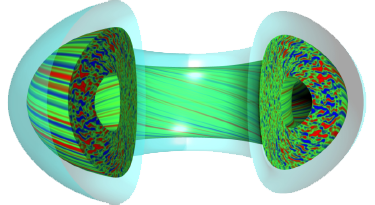Speaker
Description
The electron cyclotron emission (ECE) diagnostic is a well-established and robust instrument for the localized measurement of the electron temperature $T_\mathrm{e}$. It measures the microwave spectrum radiated by the plasma. The measured microwave intensity can be calibrated to directly deliver $T_\mathrm{e}$. The location of the measurement is determined by finding the position on the line of sight at which the measured frequency equals one of the harmonics of the cyclotron frequency.
While this simple analysis works well for the core of plasmas in current fusion devices, it is too inaccurate for the pedestal region of current H-mode plasmas, and the much hotter plasmas in future machines like ITER, SPARC, and DEMO in general. Under these circumstances, the kinetic broadening of the ECE due to the relativistic mass increase and the Doppler shift can no longer be neglected and radiation transport effects need to be included in the interpretation of the ECE measurements. This also inhibits the direct inference of $T_\mathrm{e}$, as the measurements are no longer localized, and the $T_\mathrm{e}$ information is entangled with the electron density. This challenge can be overcome by combining integrated data analysis$^1$ with a radiation transport code like ECRad$^2$. With this approach complex, ECE spectra measured at the ASDEX Upgrade tokamak can be well understood. This contribution will demonstrate this for the edge of H-mode plasmas, high-temperature, low-density scenarios with conditions for ECE similar to ITER, oblique ECE measurements, and harmonic overlap. In addition, we will highlight the importance of radiation transport modeling for future machines by discussing predictive ECE spectra for ITER and SPARC$^3$.
[1] R. Fischer et al Fusion science and technology 2010 Oct 1;58(2): 675-84.
[2] S. S. Denk et al. Computer Physics Communications 253 (2020): 107175.
[3] A. J. Creely et al. Journal of Plasma Physics 86.5 (2020).
| Country or International Organisation | United States of America |
|---|---|
| Affiliation | Plasma Science and Fusion Center, Massachusetts Institute of Technology |

